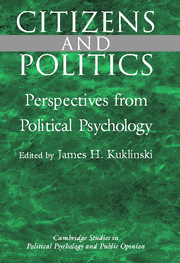Book contents
- Frontmatter
- Contents
- List of Contributors
- Prologue: Political Psychology and the Study of Citizens and Politics
- PART I AFFECT AND EMOTIONS
- PART II POLITICAL COGNITION
- PART III POLITICAL ATTITUDES AND PERCEPTIONS
- Introduction
- 9 Public Opinion and Democratic Politics: The Problem of Nonattitudes and Social Construction of Political Judgment
- 10 Implications of a Latitude-Theory Model of Citizen Attitudes for Political Campaigning, Debate, and Representation
- 11 Where You Stand Depends on What You See: Connections Among Values, Perceptions of Fact, and Political Prescriptions
- 12 Commentary: The Meaning of “Attitude” in Representative Democracies
- PART IV POLITICAL VALUES
- Index
- Titles in the series
12 - Commentary: The Meaning of “Attitude” in Representative Democracies
Published online by Cambridge University Press: 07 October 2011
- Frontmatter
- Contents
- List of Contributors
- Prologue: Political Psychology and the Study of Citizens and Politics
- PART I AFFECT AND EMOTIONS
- PART II POLITICAL COGNITION
- PART III POLITICAL ATTITUDES AND PERCEPTIONS
- Introduction
- 9 Public Opinion and Democratic Politics: The Problem of Nonattitudes and Social Construction of Political Judgment
- 10 Implications of a Latitude-Theory Model of Citizen Attitudes for Political Campaigning, Debate, and Representation
- 11 Where You Stand Depends on What You See: Connections Among Values, Perceptions of Fact, and Political Prescriptions
- 12 Commentary: The Meaning of “Attitude” in Representative Democracies
- PART IV POLITICAL VALUES
- Index
- Titles in the series
Summary
Two of the chapters in this part continue the debate over the true nature of citizens' attitudes. The third asks how accurately people perceive social and political reality and what difference it makes, a question that will take on increasing importance in the political behavior literature. All chapters speak to citizen competence, a self-evidently important topic.
In commenting on the three chapters and on related works, we emphasize intuitive appeal more and data analysis less than scholars usually do. Our discussion is divided into two main sections and proceeds as follows. In the first, we briefly revisit Converse's “Attitudes and Non-Attitudes: Continuation of a Dialogue” (1970) and Zaller's The Nature and Origins of Mass Opinion (1992). We then offer a hypothetical case of three citizens faced with evaluating the now-defeated Clinton health care proposal. What, we ask, would Converse and Zaller conclude about the existence or nonexistence of attitudes in the three cases? Do some conclusions make more sense than others? Where does the Sniderman et al. study fit in?
In the second part of the chapter, we suggest stepping away from the attitude versus nonattitude distinction and considering instead the extent to which citizens' decisions are well grounded. Although not an especially new idea, it takes us down two infrequently traveled paths: one leads to Hochschild and the role of perceptions, the other to Diamond and a latitude conception of attitudes.
- Type
- Chapter
- Information
- Citizens and PoliticsPerspectives from Political Psychology, pp. 341 - 352Publisher: Cambridge University PressPrint publication year: 2001
- 1
- Cited by

